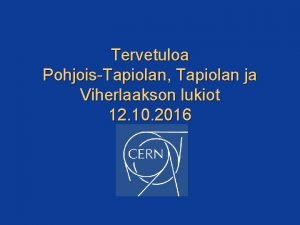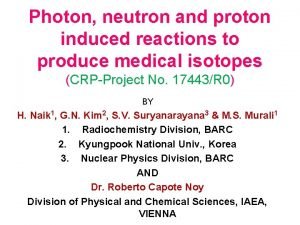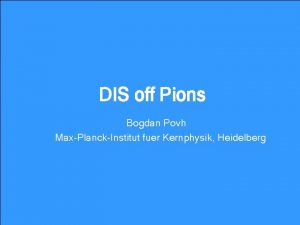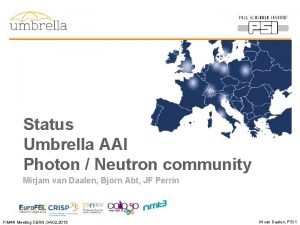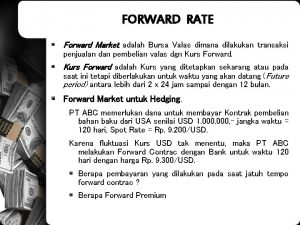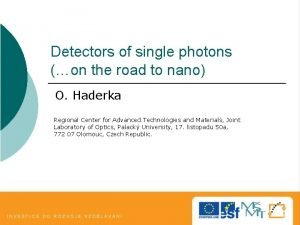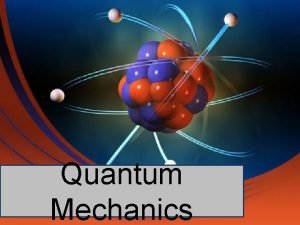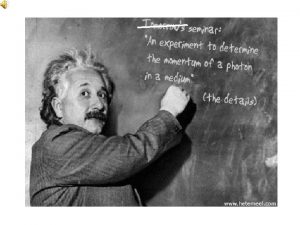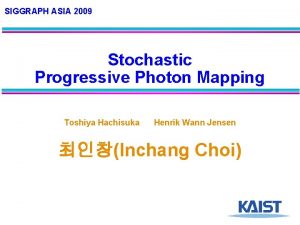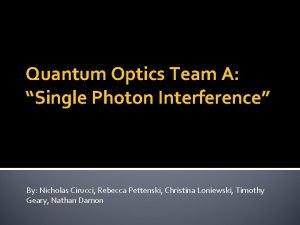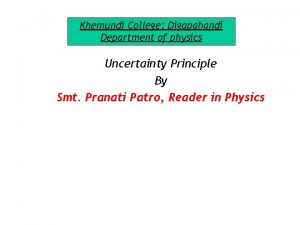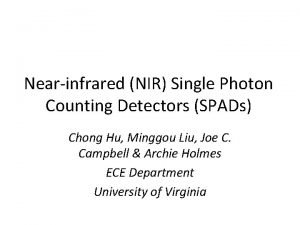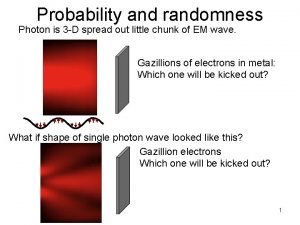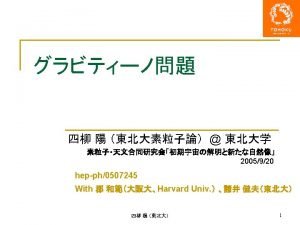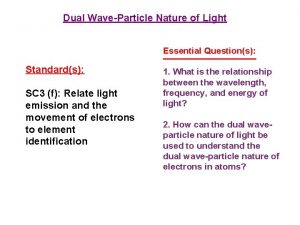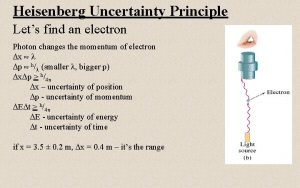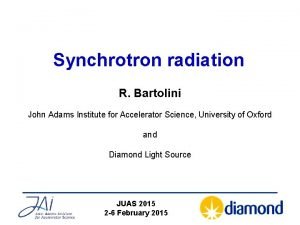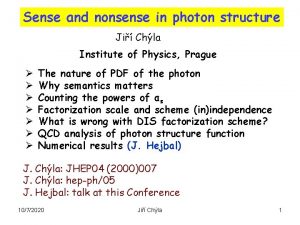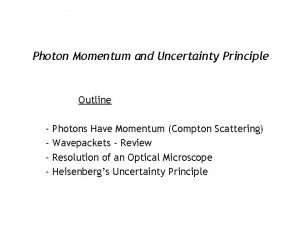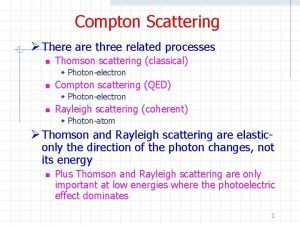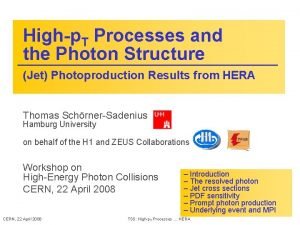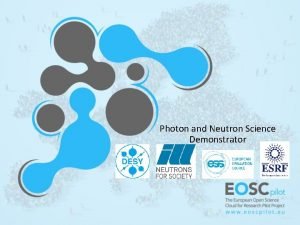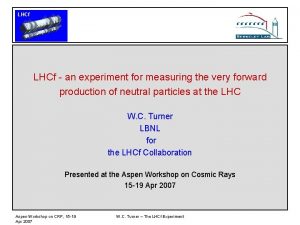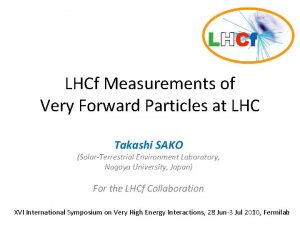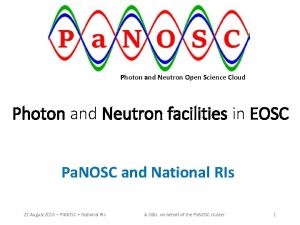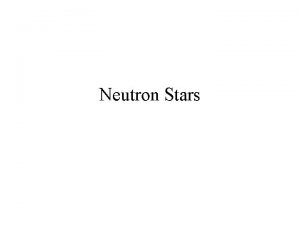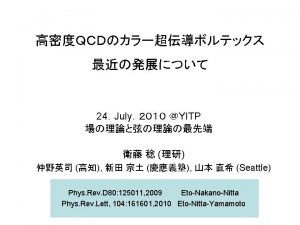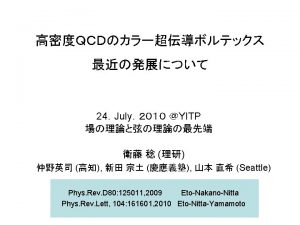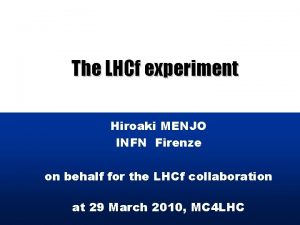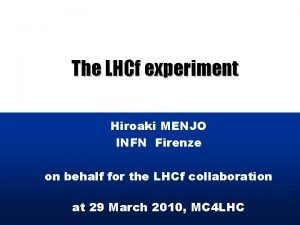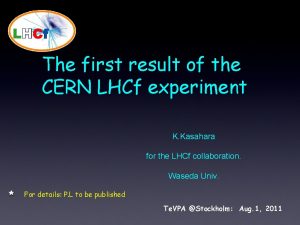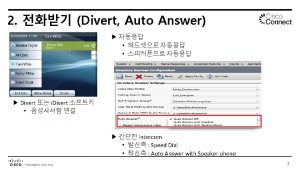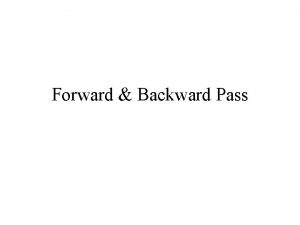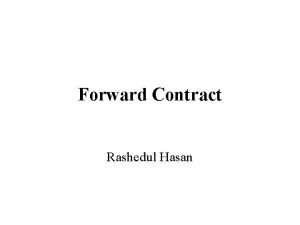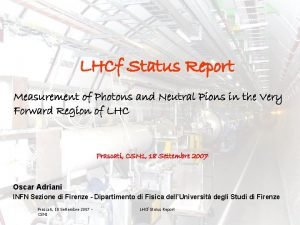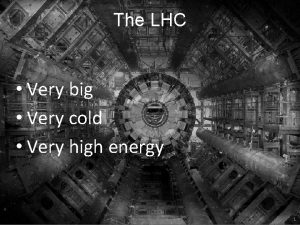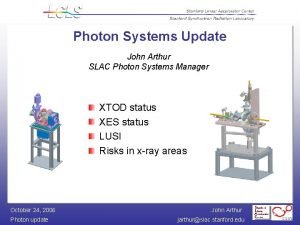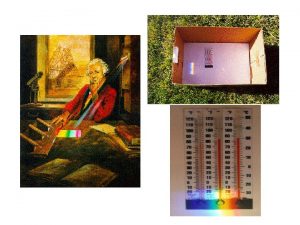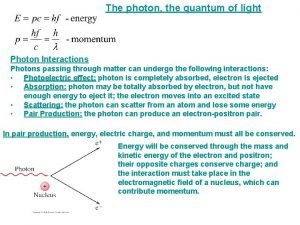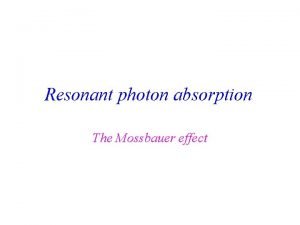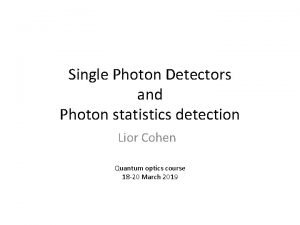The LHCf experiment Very forward photon neutron measurement































- Slides: 31

The LHCf experiment Very forward photon & neutron measurement Hiroaki MENJO (KMI, Nagoya University, Japan) On behalf of the LHCf collaboration Mini-workshop, RIKEN, 03 Oct. – 04 Oct. 2012

Contents Large Hadron Collider q Introduction q The -The most powerful accelerator on the earth- LHCf experiment -An LHC forward experimentq Operation in 2010 Ultra High Energy Cosmic Rays What is the most powerful accelerator in the Universe ? - Luminosity Measurement - Background q Analysis & Results - Forward photon energy spectra at 900 Ge. V and 7 Te. V p-p - Performance for neutron measurement q Summary Spp. S Tevatron LHC

Introduction HECRs Extensive air shower observation • longitudinal distribution • lateral distribution • Arrival direction Air shower development Astrophysical parameters • Spectrum • Composition • Source distribution Xmax distribution measured by AUGER PR Xmax the depth of air shower maximum. An indicator of CR composition N O T O N IRO Uncertainty of hadron interaction models > Error of <Xmax> measurement 1018 3 1019 Auger Coll. ICRC 2011

The LHCf collaboration T. Iso, Y. Itow, K. Kawade, Y. Makino, K. Masuda, Y. Matsubara, E. Matsubayashi, G. Mitsuka, Y. Muraki, T. Sako Solar-Terrestrial Environment Laboratory, Nagoya University, Japan Kobayashi-Maskawa Institute, Nagoya University, Japan Shibaura Institute of Technology, Japan H. Menjo K. Yoshida K. Kasahara, Y. Shimizu, T. Suzuki, S. Torii Waseda University, Japan Kanagawa University, Japan Ecole Polytechnique, France LBNL, Berkeley, USA T. Tamura M. Haguenauer W. C. Turner O. Adriani, L. Bonechi, M. Bongi, R. D’Alessandro, M. Grandi, P. Papini, S. Ricciarini, G. Castellini INFN, Univ. di Firenze, Italy K. Noda, A. Tricomi INFN, Univ. di Catania, Italy J. Velasco, A. Faus IFIC, Centro Mixto CSIC-UVEG, Spain A-L. Perrot CERN, Switzerland

The Large Hadron Collider (LHC) pp 7 Te. V+7 Te. V pp 3. 5 Te. V+3. 5 Te. V pp 450 Ge. V+450 Ge. V Elab = 1017 e. V Elab = 2. 6 x 1016 e. V Elab = 2 x 1014 e. V 2014 - Key parameters for air shower developments q CMS/TOTEM q q Total cross section ↔ TOTEM, ATLAS, CMS Multiplicity ↔ Central detectors Inelasticity/Secondary spectra ↔ Forward calorimeters LHCf, ZDCs ALICE LHCb/Mo. EDAL ATLAS/LHCf 5

The LHCf experiment LHCf Detector(Arm#1) ATLAS Two independent detectors at either side of IP 1 ( Arm#1, Arm#2 ) 140 m Beam pipe Protons Charged particles (+) Neutral particles Charged particles (-) 96 mm TAN -Neutral Particle Absorber- transition from one common beam pipe to two pipes 6 Slot : 100 mm(w) x 607 mm(H) x 1000 mm(T)

The LHCf Detectors Sampling and Positioning Calorimeters • W (44 r. l , 1. 7λI ) and Scintillator x 16 Layers • 4 positioning layers XY-Sci. Fi(Arm 1) and XY-Silicon strip(Arm#2) • Each detector has two calorimeter towers, which allow to reconstruct p 0 Expected Performance Energy resolution (> 100 Ge. V) < 5% for photons 30% for neutrons Position resolution < 200μm (Arm#1) 40μm (Arm#2) Arm 2 32 mm 25 mm Front Counter • thin scintillators with 80 x 80 mm 2 • To monitor beam condition. • For background rejection of beam-residual gas collisions by coincidence analysis 40 mm 7 20 mm Arm 1

Arm#1 Arm#2 620 mm 280 mm 92 mm 90 mm 8 280 mm

IP 1, ATLAS Arm 2 η Arm 1 Shadow of beam pipes between IP and TAN 8. 4 8. 7 ∞ is x a m a be l a r t u ne ∞ @ 140 mrad crossing angle Transverse projection of Arm#1 9 @ zero crossing angle

LHCf can measure Front view of calorimeters @ 100μrad crossing angle Energy spectra and Transverse momentum distbution of • Gamma-rays (E>100 Ge. V, d. E/E<5%) • Neutral Hadrons (E>a few 100 Ge. V, d. E/E~30%) • π0 (E>600 Ge. V, d. E/E<3%) beam pipe shadow 8. 5 ∞ at pseudo-rapidity range >8. 4 Multiplicity@14 Te. V η Energy Flux @14 Te. V High energy flux !! Low multiplicity !! 10 simulated by DPMJET 3

Expected spectra LHCf can by hadron interaction models at 7 Te. V+7 Te. V Neutron Gamma-rays Different interaction model gives different production spectra in the forward region. It means the LHCf can discriminate the interaction models. (Note : Spectra of QGSJET 1 & 2 are wrong. ) 11 p 0

Status of the LHCf experiment 2009 q First full data taking with √s = 900 Ge. V p-p collisions. 2010 q Physics programs with √s = 900 Ge. V and 7 Te. V p-p collisions has been completed. 2012 q q Phase I operation. • Forward Photons • Forward π0 • (Neutrons, Keons etc. ) Upgrade the Arm 1 detector. Calibration of detectors with beams at SPS (Aug. ) 2013 q q Operation with p-Pb collisions (Nov. ) Upgrade the Arm 2 detector 2014 (2015? ) q Operation with √s = 14 Te. V p-p collisions 2015 ? q Operation at RHIC Future operations • Nuclear effect • Energy dependency

Operation Dec. 2009 in the LHCf control ro

Data taking in 2010 At 450 Ge. V+450 Ge. V 108 02 May – 27 May in 2010 ~15 hours for physics ~44, 000 and ~63, 000 shower events in Arm 1 and Arm 2 Int. number of recorded events Showering π0 At 3. 5 Te. V+3. 5 Te. V 30 Mar. – 19 July in 2010 ~ 150 hours for physics with several setup With zero crossing angle and with 100μrad crossing angle. ~2 x 108 and ~2 x 108 shower events in Arm 1 and Arm 2 DAQ specification Max. DAQ rate 1000 Hz (Arm 1), 800 Hz (Arm 2) Trigger Any 3 successive layers d. E > d. Eth (Shower events. ) Trigger Efficiency 100% for 50 Ge. V photons @ normal gain mode 100% for 30 Ge. V photons @ high gain mode.

Luminosity monitoring by FC from LHC Vistor page Beam energy intensity of beam 1 intensity of beam 2 Ramping up beam energy (~1 hours) Filling bunches Adjusting beams (~0. 5 hours) Coincidence rate of Arm 1 & 2 FC’s 15

Backgrounds • Secondary - Beam Pipe Simulation @ p-p √s=14 Te. V The background events dominate in the lower energy region (<100 Ge. V). S/N (E>100 Ge. V) > 100. • Beam - Gas Interaction • Two side coincidence The energy spectrum of beam-gas background is similar to the single spectrum (p-p collisions. ) Amount of BKG can be estimated by using non-crossing bunch (next page. ) • π0 analysis Background rejection by vertex selection.

Beam-gas Background @ LHC The beam-gas background can be measured by using non-Xing bunches at IP 1. Xing bunches : Collision(Signal) + BKG Non-Xing bunches : BKG @√s=900 Ge. V, 2010 > 10 @√s=7 Te. V, 2010 x 103

Analysis & Results - Photons - (Neutrons) “ Measurement of zero degree single photon energy spectra for √s = 7 Te. V proton-proton collisions at LHC “ O. Adriani, et al. , PLB, Vol. 703 -2, p. 128 -134 (09/2011) “Measurement of zero degree inclusive photon energy spectra for √s = 900 Ge. V proton-proton collisions at LHC“ O. Adriani, et al. , Submitted to PLB. , CERN-PH-EP-2012 -048

Analysis for the photon spectra q DATA o 15 May 2010 17: 45 -21: 23, at Low Luminosity 6 x 1028 cm-2 s-1 o 0. 68 nb-1 for Arm 1, 0. 53 nb-1 for Arm 2 q MC o DPMJET 3. 04, QGSJETII 03, SYBILL 2. 1, EPOS 1. 99 PYTHIA 8. 145 with the default parameters. o 107 inelastic p-p collisions by each model. q Analysis Procedure o Energy Reconstruction from total energy deposition o o in a tower with some corrections, shower leakage out etc. Particle Identification by shape of longitudinal shower development. Cut multi-particle events. Two Pseudo-rapidity selections, η>10. 94 and 8. 81<η<8. 9. Combine spectra between the two detectors.

Event sample Longitudinal development measured by scintillator layers 25 mm Tower 32 mm Tower 600 Ge. V 420 Ge. V photon Total Energy deposit Energy Shape PID Lateral distribution measured by silicon detectors X-view Hit position, Multi-hit search. Y-view π0 mass reconstruction from two photon. Systematic studies

Particle Identification q Event selection and correction Calorimeter Depth – Select events <L 90% threshold and multiply P/ε Elemag: 44 r. l. Hadronic: 1. 7λ ε (photon detection efficiency) and P (photon purity) – By normalizing MC template L 90% to data, ε and P for certain L 90% threshold are determined. d. E L 90% Distribution Photon Hadron Integral of d. E Calorimeter layers

Multi-hit identification q Event cut of multi-peak events, o Identify multi-peaks in one tower by position sensitive layers. o Select only the single peak events for spectra. An example of multi peak event Double hit detection efficiency Small tower Large tower Arm 1 Single hit detection efficiency Arm 2

Photon spectra at √s = 7 Te. V p-p 8. 81<η<8. 9 q q Pseudo-rapidity, η>10. 94 and 8. 81<η<8. 9 The spectra of two detectors are consistent within the errors. Arm 1 detector Arm 2 detector η>10. 94 Arm 1 Arm 2

Photon spectra at √s = 7 Te. V p-p Data Sys. +Stat. DPMJET 3. 04 QGSJETII-03 SIBYLL 2. 1 EPOS 1. 99 PYTHIA 8. 145 • • No model can reproduce the LHCf data perfectly. DPMJET and PYTHIA are in good agreement Eγ<1. 5 Te. V, but harder in E>1. 5 Te. V. QGSJET and SIBYLL shows reasonable agreement of shapes in high-η but not in low-η EPOS has less η dependency against the LHCf data.

Photon spectra at √s = 900 Ge. V p-p Data Sys. +Stat. MC/Data DPMJET 3. 04 QGSJETII-03 SIBYLL 2. 1 EPOS 1. 99 PYTHIA 8. 145 • Both of Data and MC show little η dependency. • The tendencies of MC against Data are very similar to one of 7 Te. V in η > 10. 94.

DATA : Comp. 900 Ge. V/7 Te. V Coverage of 900 Ge. V and 7 Te. V results in Feynman-X and PT XF spectra : 900 Ge. V data vs. 7 Te. V data 900 Ge. V vs. 7 Te. V with the same PT region Preliminary ll-η a m s Data 2010 at √s=900 Ge. V (Normalized by the number of entries in XF > 0. 1) Data 2010 at √s=7 Te. V (η>10. 94) Good agreement of XF spectrum shape between 900 Ge. V and 7 Te. V. weak dependence of <p. T> on ECMS Note : No systematic error is considered in both collision energies. 21% of the luminosity determination error allows vertical shift.

Neutron analysis q Leading baryon measurement of Inelasticity q Large difference of expected energy spectra in the forward region between models. MC true (η > 10. 94) Smeared by 35% resolution MC smeared (η > 10. 94)

Performance studies for neutrons are on going. Energy Resolution Detection Efficiency ~ 70% @ >500 Ge. V Arm 1 Arm 2 Position Resolution 1. 5 mm @ 1 Te. V n 30 -35% @ > 1 Te. V

Summary q q LHCf has measured the energy and transverse momentum spectra at the very forward region of √s = 900 Ge. V and √s =7 Te. V p-p collisions in 2010. We showed the spectra of very forward photons at √s = 900 Ge. V and 7 Te. V p-p collisions and π0 s at √s = 7 Te. V p-p collisions. No model can produce data perfectly but the data are located in the middle of the model predictions.

Backup slides

900 Ge. V photon analysis Cross section of LHCf detectors Beam pipe shadow Arm 1 Beam pipe shadow Arm 2 Two pseudo-rapidity ranges • - η>10. 15 - 8. 77<η<9. 46 Arm 1 and Arm 2 data show an overall good agreement within their systematic uncertainties. Arm 1 data vs Arm 2 data
 Lhcf
Lhcf Ortec 257p
Ortec 257p Dis off
Dis off Photon neutron
Photon neutron Mirjam van daalen
Mirjam van daalen Rumus forward rate
Rumus forward rate Forward market adalah
Forward market adalah It is a very shallow skillet with very short sloping sides
It is a very shallow skillet with very short sloping sides Figure 10
Figure 10 Quantifiers for food
Quantifiers for food Scientific notation rules
Scientific notation rules Few fewfewf
Few fewfewf Photons
Photons A photon checks into a hotel
A photon checks into a hotel Momentum of photon
Momentum of photon Stochastic progressive photon mapping
Stochastic progressive photon mapping Jim al khalili
Jim al khalili De broglie wavelength formula
De broglie wavelength formula Momentum of photon
Momentum of photon Single photon
Single photon Electron vs photon
Electron vs photon Photon chunk
Photon chunk Lepton-photon
Lepton-photon Photon is our business
Photon is our business Photon
Photon Photon uncertainty principle
Photon uncertainty principle Photon density formula
Photon density formula Chrysos corporation
Chrysos corporation Photon structure
Photon structure Momentum of photon
Momentum of photon Photon cross section
Photon cross section Photon structure
Photon structure
